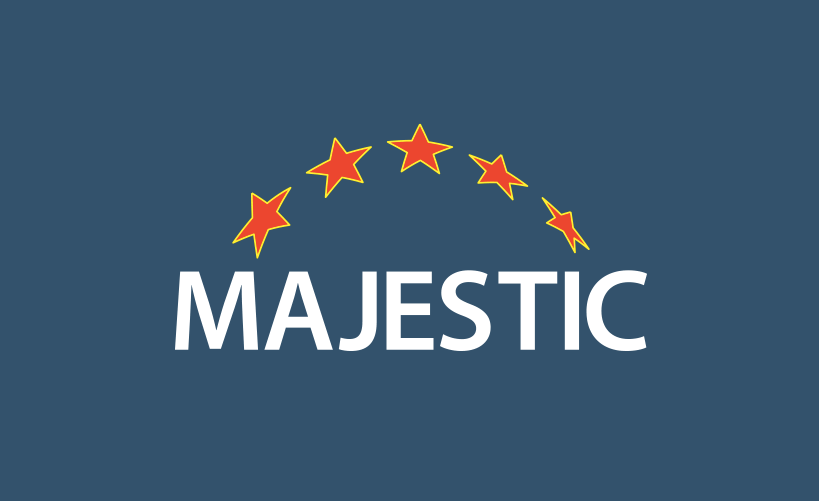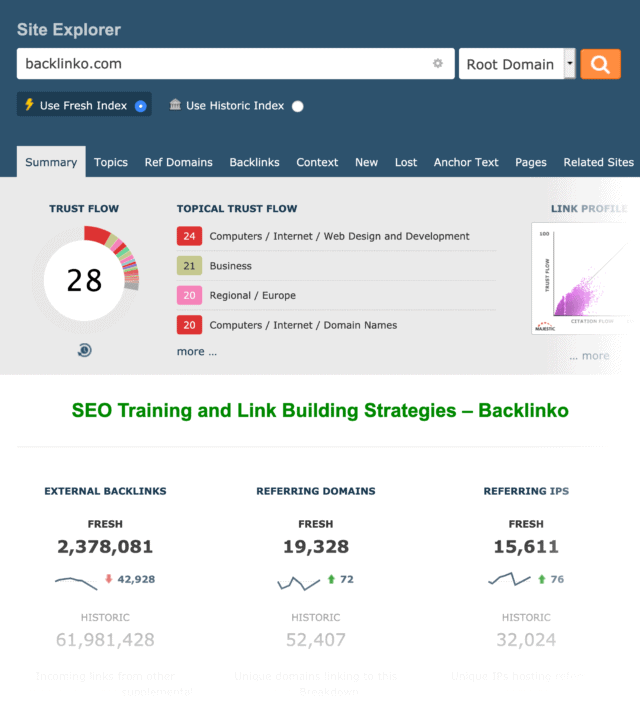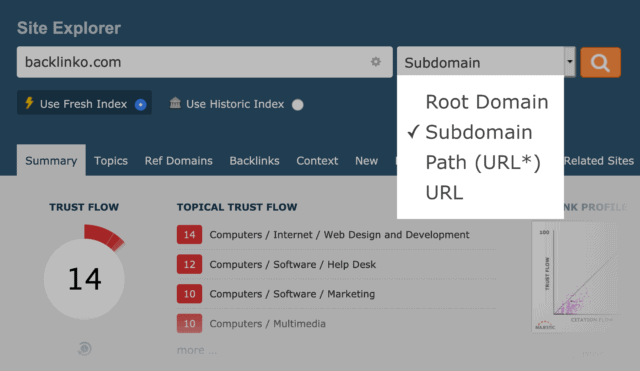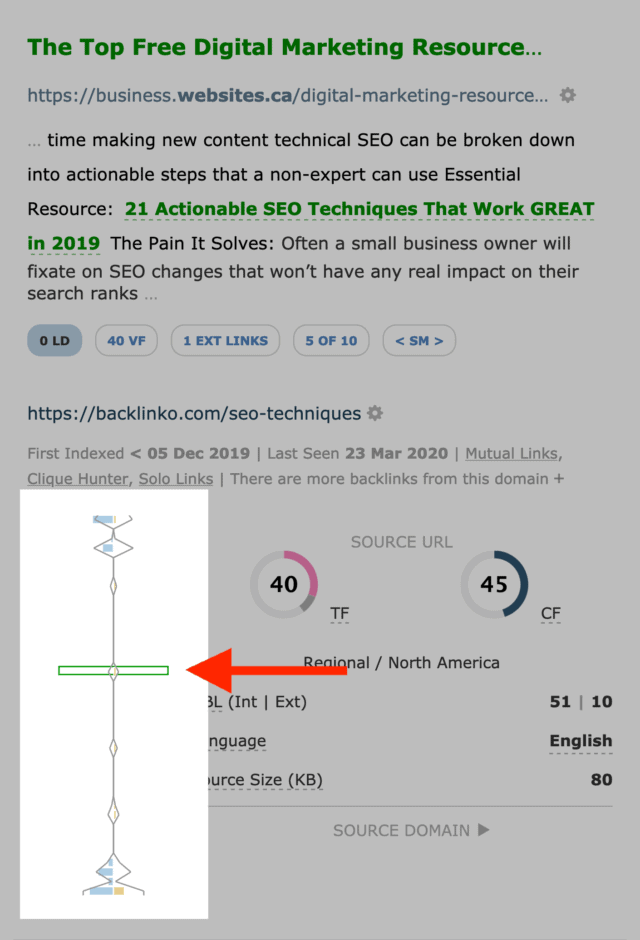

My name is Terry Williams and I have been in charge of SEO at my agency for the past 5 years. Within this time I've used Majestic SEO extensively and would like to give you my honest feedback of the software. This comprehensive Majestic SEO review will break down everything you need to know about Majestic SEO, a powerful link analysis tool for SEO.
We'll cover key topics like:
In short, this guide will give you an in-depth look at Majestic SEO to determine if it should be part of your SEO stack.
The budget pricing and massive index give Majestic appeal. But the advanced metrics seem vague compared to competitors' concrete data-driven tools.
Price: ⭐⭐⭐⭐⭐
Very affordable plans compared to rivals, with the Lite tier being only $49.99 per month.
Accuracy: ⭐⭐⭐
Questionable Keyword Checker data hurts credibility. Flow metrics lack transparency. But index seems robust.
Features: ⭐⭐⭐
Covers backlink essentials without advanced functionality seen in Ahrefs, SEMrush, Moz. But interface is dated.
In summary, Majestic carves out a place in the market based on budget pricing. It index seems sufficiently large and comprehensive. However, the unique metrics need more clarity to be useful.
For extensive link data and insights, other tools exceed Majestic. But for basic affordable backlink tracking, it gets the job done.
Majestic SEO is an SEO software focused entirely on backlink analysis and link building, unlike all-in-one tools like Ahrefs, SEMrush, and Moz.
Majestic specializes exclusively in links, which allows it to offer what it claims are the most comprehensive backlink data and metrics available.

We'll evaluate this claim in the review when we dive into Majestic's features for backlink research, tracking competitor links, analyzing link profiles, and more.
For now, understand that Majestic is a targeted tool centered on links rather than a suite covering multiple aspects of SEO. Its aim is unparalleled depth and capabilities specifically for link analysis.
The Site Explorer Summary provides an overview of key link metrics for a target website. It delivers a bird's-eye view of the site's overall link profile.

Key data points shown include:
By changing the dropdown to "subdomain", "path", or "URL", you can also view detailed link data for specific pages.

The Site Explorer Summary offers a single dashboard to quickly analyze and monitor the full scope of a site's backlink profile. You can assess link metrics at a global or granular level to identify opportunities.
This high-level snapshot contextualizes the more in-depth linking data contained in the other Site Explorer tools.
The Topics report provides insight into a site's authority and relevance by analyzing where it earns links from.
Rather than judging authority based on published content, Majestic determines topical authority from a site's referring domains.
For example, if a health and fitness site gets most of its links from other respected health/wellness sites, Majestic will identify "Health and Fitness" as a topical authority topic.
This shows search engines the site is trusted and valued in that space specifically. Earning niche links confirms expertise on a subject.
I haven't seen this unique approach to identifying authority in other tools. Referring domains provide clearer context compared to just analyzing a site's content alone.
Gauging authority through linker topics gives a true external measure of how industry peers view the site.
This section displays domains currently linking to the analyzed site. Helpful data includes:
One confusing element is the "Backlinks" column - this seems to show the total backlinks for the referring domain, not specifically links to your site.
Some of the numbers appear suspiciously high, like domains supposedly having hundreds of thousands of backlinks. This data raises accuracy questions.
Still, the list provides a starting point to evaluate current link sources and identify authoritative sites to pursue backlinks from. Just take the link numbers with a grain of salt.
Majestic's Backlinks Report provides an extensive list of all backlinks pointing to a target site. This allows deep analysis of the site's full backlink profile.
You can filter, sort, and customize the backlink list in 100+ different ways. For example:
A unique column shows the number of external links on each page linking to your site. This provides context on potential "PageRank leakage" from pages overloaded with outward links.
The comprehensive sorting and filtering capabilities let you segment backlink data to surface optimization opportunities:
In summary, Majestic's flexible backlink list enables drilling down into granular details to inform link building strategies. The ability to customize link data views is extremely valuable.
The Context Report provides granular details on each individual backlink pointing to a site. This reveals insights on the on-page link environment.
Each link displays handy tags indicating attributes like:
But the most unique element is the Link Density charts. These visualize WHERE on a page your link appears.
You can see if a link is surrounded by other links at the top, middle, or bottom of content. Links packed densely near other navigation links typically lack editorial context.
Whereas a link appearing in a sparse area within core content shows it's an integral editorial mention. Like this example link to my site:

The page has minimal links mid-content, highlighting my contextual editorial backlink.
This lets you deeply assess the contextual value of each link placement. Uncovering these insights takes link analysis to an advanced level compared to simply compiling a list of domains.
The Context Report shines a light on each link's location and environment - extremely helpful for identifying the strongest and weakest backlinks.
This straightforward report lists any recently gained or lost backlinks pointing to a site. Monitoring new and dropped links is vital for tracking link velocity and identifying issues.
Key features include:
Quickly scan for any high-quality new link wins or concerning losses of important backlinks. This equips you with actionable link building intel.
The Anchor Text breakdown shows the most prevalent text used in links pointing to a site. This reveals opportunities to improve link diversity.
Handy features:
One drawback is that exact percentages for each term aren't shown directly within the report itself. You need to pull this from the Site Explorer summary.
Still, the cloud and list provide at-a-glance insights into a site's anchor text profile and risks of over-optimization. This helps guide link outreach to pursue more varied, natural anchor text.
The Pages Report reveals the specific pages on a site accruing the most backlinks. This highlights areas of strong authority to leverage.
Key elements:
Quickly identify the pages attracting the most links to diagnose link building wins and gaps. Then double down on optimizing pages with proven link appeal.
The Related Sites section provides a list of the most similar sites to the one analyzed, based on link profiles. The results can generate great link building ideas.
When testing with sites I'm familiar with, Majestic's related sites are eerily accurate. The lists truly surface authoritative sites with overlapping audiences.
Scoring backlinks from these related sites makes sense - if they already link to competitors with similar content, they likely would welcome your content as well.
The qualitative, human-vetted feel of these recommendations makes Majestic's related sites uniquely useful. The lists provide solid link prospecting inspiration.
The Compare Domains tool allows viewing link profiles side-by-side for 2-5 sites. This helps identify common patterns and differences.
Within this section, Clique Hunter surfaces domains that link to multiple sites being compared - powerful prospects for your own outreach.
If a site links to competitors in your space, they're significantly more likely to link to you as well compared to random sites.
The Keyword Checker tool aims to provide estimated search volume data based on keyword usage and frequency across the web. However, in my experience as an SEO professional, the accuracy of the volume estimates is questionable.
For example, when searching for "keto diet" - a term that likely gets thousands of searches per month - Keyword Checker states the volume is only 67. The estimates seem wildly inaccurate compared to more reliable tools.
While an interesting idea in concept, poor explanation of how estimates are calculated makes it difficult to trust or properly utilize the Keyword Checker. I'm unsure if the methodology scales well beyond scoring general web term popularity.
In its current iteration, the tool adds little value for serious keyword research. Reliable search volume data is vital for strategy. Unfortunately Keyword Checker misses the mark in this regard.
Majestic has developed proprietary metrics designed to gauge website credibility and authority:
Trust Flow - Similar to TrustRank, this score reflects how many links a site receives from a manually curated set of trusted seed sites. The seeds pass authority to the sites they link to.
Citation Flow - Equivalent to Domain Authority, Citation Flow increases when you garner backlinks from authoritative sites.
Topical Trust Flow - Breaks down the specific types of sites that are linking to you. Not just authority but topical relevance is important.
These provide interesting supplemental data on qualitative factors that influence search rankings beyond sheer link numbers. However, the secrecy around seed site selection and other calculations makes the potential SEO value unclear.
While conceptually there are merits to these metrics, they seem to add little actionable guidance beyond reinforcing basic best practices - earn links from reputable topically related sources.
Majestic claims to have the largest backlink index, so I compared it against leading alternatives like Ahrefs, SEMrush, and Moz to see if this holds true.
I analyzed two sites - my own Backlinko.com, and the authoritative domain Healthline.com.
For Backlinko.com, Majestic found 65 million backlinks from 51k referring domains. Ahrefs showed 1.2 million backlinks and 21k domains. SEMrush and Moz were in the 1.6 million and 635k range respectively.
On the larger Healthline.com site, Majestic indexed 57 million backlinks from 351k referring domains. Ahrefs came closest with 54 million backlinks and 297k domains. SEMrush showed 19 million backlinks, and Moz had 9.5 million indexed.
While anecdotal, this small dual-site analysis suggests Majestic's index is extremely large and likely the biggest available. However, larger doesn't necessarily mean better quality. The value depends on the relevance of links indexed.
But Majestic appears extremely competitive with other major tools in terms of index size, if not exceeds them by orders of magnitude in some cases. Yet I'm doubtful it truly has the largest index as claimed. Additional testing on a broader range of sites would provide more clarity.
Beyond features, I wanted to test Majestic's customer support by submitting a question about interpreting one of their metric scores.
Within 51 minutes I received a thoughtful, thorough reply using my own site as an example. This level of personalized, prompt support is impressive.
Based on this limited trial, I'd rate their customer service as excellent. However, consistently providing such helpful responses at scale to all users would be the true test.
The knowledgeable support agents definitely augment Majestic's offering. But the toolset itself needs to provide sufficient value independent of relying on the team for guidance.
Majestic offers two primary monthly plans:
There is also an Enterprise tier with API access.
Compared to competitors like Ahrefs and SEMrush, which both start at $99/month, Majestic's pricing is much more affordable.
The Lite plan is 50% cheaper at only $49.99 per month. This budget-friendly pricing makes Majestic accessible to a wider range of users.
For alternatives to Majestic with more robust features, consider:
Majestic SEO stands out through its budget-friendly pricing and enormous link index containing 57 billion+ backlinks. This makes it accessible for users wanting basic backlink research.
However, the interface and proprietary metrics feel dated compared to sophisticated alternatives like Ahrefs and SEMrush. The vague Trust and Citation Flow scores provide little actionable SEO guidance.
For comprehensive and accurate link data, Majestic trails behind the competition. But as an affordable starting point for backlink analysis, it holds appeal to value-focused users.
Does Majestic integrate with other tools?
Yes, Majestic offers API access to integrate with SEO platforms like SEMrush, Moz, and SurferSEO for expanded capabilities.
Is there a free version of Majestic?
No free plan is available. However, they offer a 7-day free trial to test the system using your own data.
What is Majestic's crawl frequency?
The index is updated frequently but the exact crawl rate is proprietary. Assume near real-time freshness of backlink data.
Can I resell Majestic access to clients?
No, their terms prohibit reselling access. Client reporting features help showcase Majestic data.
How far back does Majestic's index go?
It contains historical link data as far back as 1996, providing unmatched depth of historical data.

Leave a Reply
You must be logged in to post a comment.